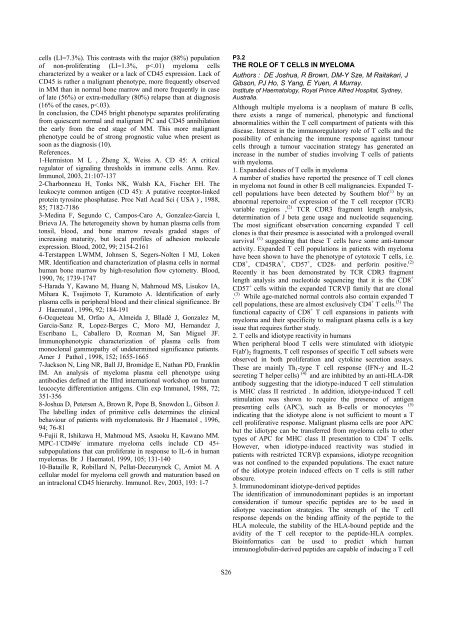Haematologica 2003 - Supplements
Haematologica 2003 - Supplements Haematologica 2003 - Supplements
cells (LI=7.3%). This contrasts with the major (88%) population of non-proliferating (LI=1.3%, p
esponse and have demonstrated that CD8+ cells can recognise shared immunoglobulin-derived peptides bound to MHC class I molecules. (6) Thus, it may be possible to develop a small set of shared peptides capable of inducing a T cell response in a range of patients. Certainly the ability to predict immunodominant peptides has significant implications for vaccination strategies in the treatment of all B-cell malignancies. We have recently used this method to predict immunodominant peptides from the sequence of the CDR3 region of the IgH gene of 16 patients with myeloma. (1) CDR3 peptides from most patients failed to achieve a BIMAS score of 100, suggesting that the poor affinity between the unique peptides and the patient's HLA would fail to generate a significant T cell response. As most immunodominant peptides in other B cell malignancies were found outside the CDR3 region (6) and more often in framework regions, future studies in patients with myeloma should not expect that immunodominant peptides with the potential to stimulate anti-tumour T cell activity will only be found in the CDR3 region. 4. Identification of idiotype-specific T cells using MHC Class I Tetramers MHC tetrameric complexes offer the possibility to identify and manipulate peptide specific T cells. We have sequenced the hypervariable regions of both the heavy and light chain hypervariable regions of 6 patients with expanded CD8+ clones, used bioinformatics to demonstrate that only 3 of the six patients had immunodominant idiotypic peptides and prepared tetrameric MHC class I complexes containing CDR-derived immunodominant peptides to search for idiotype-specific T cells in the blood of the 2 surviving patients. Initial studies which failed to detect tetramer positive cells in either patient suggested that idiotype-specific T cells were deleted. Modified staining techniques demonstrated that tetramer positive T cells comprised 1-10% of an IL-2 activated T cell population (
- Page 1 and 2: Focussed Symposia Arsenic trioxide
- Page 3 and 4: assess whether such a program will
- Page 5 and 6: The overall response rate was noted
- Page 7 and 8: Figure 5A Table 1: VEL + THAL for R
- Page 9 and 10: naturally occurring OPG. Present tr
- Page 11 and 12: 0.505). Finally, the multiple event
- Page 13 and 14: CLINICOPATHOLOGICAL DEFINITION OF W
- Page 15 and 16: Plenary Sessions 1. Development of
- Page 17 and 18: clonotypic IgH VDJ signature confir
- Page 19 and 20: can be considered as two entities,
- Page 21 and 22: immunofluorescence staining for DKK
- Page 23 and 24: P2.3 DEVELOPMENT OF A MULTIPLE MYEL
- Page 25 and 26: P2.5 MOLECULAR CYTOGENETICS OF MYEL
- Page 27: clear that the biggest challenge fo
- Page 31 and 32: variable region of the idiotypic im
- Page 33 and 34: 4. From MGUS to symptomatic MM Fig.
- Page 35 and 36: (MRI); some have claimed that level
- Page 37 and 38: P4.5 CYTOKINES IN MGUS: THERAPEUTIC
- Page 39 and 40: preventing phosphorylation of p70S6
- Page 41 and 42: transducing component of the interl
- Page 43 and 44: survive initial drug exposure and a
- Page 45 and 46: quiescent counterpart, the human um
- Page 47 and 48: transcriptional activity of NF-êB;
- Page 49 and 50: manifestations and anomalous protei
- Page 51 and 52: P7.4 ROLE OF SERUM FREE LIGHT CHAIN
- Page 53 and 54: P7.6 IMMUNOPHENOTYPIC INVESTIGATION
- Page 55 and 56: presumably through the circulation,
- Page 57 and 58: 9. Chemotherapy, maintenance treatm
- Page 59 and 60: stratified according to their antim
- Page 61 and 62: explore higher doses of zoledronic
- Page 63 and 64: initial therapy. However, the role
- Page 65 and 66: P10.2.2 SINGLE VERSUS TANDEM HIGH D
- Page 67 and 68: With a median follow-up of 38 month
- Page 69 and 70: cells could be harvested following
- Page 71 and 72: 11. What is the role of allogeneic
- Page 73 and 74: found that 75% of patients who were
- Page 75 and 76: patients with responsive disease 3
- Page 77 and 78: 9. Giralt S, Estey E, Albitar M, et
cells (LI=7.3%). This contrasts with the major (88%) population<br />
of non-proliferating (LI=1.3%, p



